Psychology Topics > Sensation and Perception
Sensation and perception are vital parts of how we make contact with the outside world. Sensations can be defined as the passive process of bringing information from the outside world into the body and to the brain. The process is passive in the sense that we do not have to be consciously engaging in a "sensing" process.
In addition, when discussing Sensation, we're really referring to the 5 physical senses; taste, touch, sight, sound, and smell.
Some theorists have also added a 6th sense (and no, it's not the ability to see dead people) called intuition. Intuition is similar to instinct and is defined as an ability to be able to perceive something without having to discover it or perceive it. For example, sometimes we are able to sense danger without really knowing all the reasons why.
Perception can be defined as the active process of selecting, organizing, and interpreting the information brought to the brain by the senses. Perception varies from one individual to the next and is largely based on past experiences.
As you can imagine, Sensation and Perception work together - one isn't much good without the other. Let's look at how they function together:
Sensation occurs in the following way:
- sensory organs absorb energy from a physical stimulus in the environment.
- sensory receptors convert this energy into neural impulses and send them to the brain.
Perception occurs in the following way:
- the brain organizes the information and translates it into something meaningful.
In order to understand how they work together, we need to determine the meaning of "meaningful". How do we know what information is important and should be focused on?
Selective Attention - process of discriminating between what is important & is irrelevant (Seems redundant: selective-attention?), and is influenced by motivation. For example - students in class should focus on what the teachers are saying and the overheads being presented. Students walking by the classroom may focus on people in the room, who is the teacher, etc., and not the same thing the students in the class.
Perceptual Expectancy - how we perceive the world is a function of our past experiences, culture, and biological makeup. For example, as an American, when I look at a highway, I expect to see cars, trucks, etc, NOT boats. But someone from a different country with different experiences and history may not have any idea what to expect and thus be surprised when they see cars go driving by.
Sensation and Perception together can be referred to as Psychophysics, which can be defined as, the study of how physical stimuli are translated into psychological experience. For a more thorough explanation of psychophysics, please check out our sensation and perception notes: https://www.alleydog.com/101notes/s&p.html
This section is not meant to be an exhaustive discussion of how we are able to sense things, but it is meant to be a very basic summary. These processes will be explained as a series of steps in each section.
Sight
There are many parts of an eye but the basic ones are the cornea, iris, retina, optic nerve and pupil.
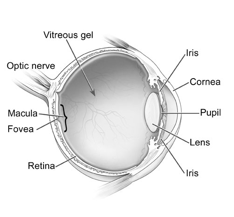
source: http://www.ncbi.ie/information-for/eye-health-and-eye-care/your-eye
- Our eye is stimulated by various wavelengths of light. The different wavelengths are responsible for the diversity of colors we see. There are many other types of waves that our eye cannot detect.
- The light passes through the cornea, a clear protective covering of the eye.
- The light passes through a hole in the iris (the colored part). This hole is also called the pupil. The size of the pupil changes depending upon how bright the environment is. In the daytime, it will be smaller to prevent the eye from receiving too much light. At night, or in the dark, the pupil widens to allow as much light as possible into the eye.
- The light passes through the lens which is located right behind the pupil. The lens of the eye is similar to the lens on a camera, however, it is much more efficient. It accommodates quickly depending upon whether the image is close or far away, similar to how a person needs to focus the lens of a camera.
- The image finally reaches the retina. The retina is located towards the back of the eye and it consists of 2 types of cells; rods and cones. Rods differentiate black and white and grays. Cones are the cells responsible for differentiating color.
Sound
The main parts of the ear are the pinna, auditory canal, eardrum, hammer, anvil, stirrup, cochlea, vestibular system and auditory nerve. (see below)
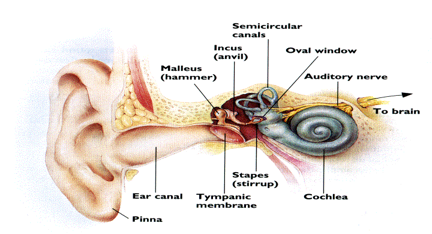
source: http://www.arts.uwaterloo.ca/~dcrowne/psych101/ear.gif
- Sounds are actually series of vibrations that are picked up and interpreted by our ears and brain. In the first step, the vibrations are picked up by our outer ear or pinna and are then passed through the auditory canal to the tympanic membrane (ear drum).
- Our ear drum vibrates according to the intensity of the sound. Lower sounds cause more and bigger vibrations than softer sounds. Then these vibrations are passed to the middle ear which is made up of three bones, the anvil, hammer, and stirrup.
- These three bones transfer the vibrations to the inner ear which consists of the cochlea and semicircular canals. The inner ear is responsible for translating the vibrations into information that can be processed by the brain via the auditory nerve. This explanation is overly simplified of course when the process is actually very complex.
- Another vital function of the ear concerns our sense of balance. This process involves tiny crystals called otoliths in the semicircular canals. They are motion sensitive and move as our head and body shifts from side to side. This explains why when an individual has a severe ear infection, their sense of balance is affected.
Smell and Taste
Smell and Taste are somewhat related. Have you ever noticed that when your nose is stuffy things taste differently? This is because we use our sense of smell when we taste things. Lets overview our sense of smell first.
Here is an illustration of what the nose looks like on the inside. Our nose is covered with thousands of olfactory cells in the nasal cavity. Groups of these olfactory cells are sensitive to particular odors that help us differentiate between various smells. The responses of these cells are then transmitted and processed in the corresponding part of the brain responsible for smell.
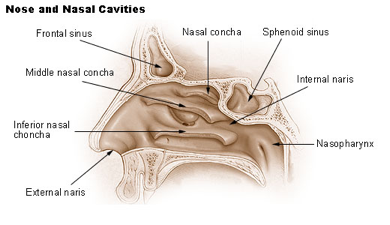
source: http://www.web-books.com/eLibrary/Medicine/Physiology/Respiratory/Respiratory.htm
An additional interesting fact about the sense of smell is that we have a very good memory of smells. As far as memory is concerned, a scent is the strongest association we have for recall of particular memories. Just think of the smells of Christmas time or other holiday smells and how they bring back strong memories of past experiences.
Our sense of smell and taste are also important survival mechanisms. For example, it prevents us from eating rotten food that could make us sick. If you have ever gotten food poisoning from something, even if it is prepared correctly in the future, it would be hard to eat it again because the memory of being sick from it is so strong.
Taste
Our sense of taste is sensitive to 4 basic tastes; bitter, salty, sweet, and sour. Some theorists have added a fifth taste, savory, to that list. We have over 10,000 taste receptor cells on our tongue and they wear out and are replaced approx. every ten days. The specific taste receptors for the basic tastes of bitter, salty, sweet and sour are located in certain places on our tongue. (see figure below.) Some people have more sensitive taste receptors than others. As explained previously, our sense of smell and taste combine when we eat something and this information is processed in the brain and identified as a particular taste.
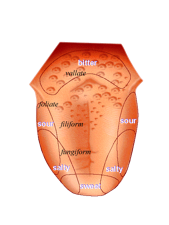
source: http://www.web-books.com/eLibrary/Medicine/Physiology/Respiratory/Respiratory.htm
Touch
Our sense of touch takes into account 4 different pieces of information; pressure, temperature, touch or texture, and pain. Each of these factors is vital for the combined sense of touch. For example, if you cannot sense pressure, you would not be able to hold a glass because you would either hold it so loosely that you would drop it, or so tightly that it would shatter. Our sense of temperature keeps us from holding items that are too hot and could cause burns, or too cold that would cause frost bite. Our sense of pain is also vital because it alerts us that there is a problem or infection that needs treatment.

source: http://www.factmonster.com/images/ESCI351SKIN003.gif
Gestalt
A gestalt is defined as an object, idea, or experience as being more than the sum of its parts. The theorists of gestalt perceptional laws were Max Wertheimer, Wolfgang Köhler, and Kurt Koffka. The art of M.C. Escher and Bev Doolittle are good examples of gestalt paintings.
The following are several terms used in our perception of gestalts, i.e. the world around us.
- Proximity: we group things that are close together instead of keeping them separate.
- Closure: we ignore gaps and complete or fill them in based on our experiences to define an object.
- Similarity: we tend to group items that are similar.
- Simplicity: we see figures as simplistically as possible.
- Continuation: we see lines or shapes as continuing through other forms instead of stopping.
- Figure and Ground: we tend to separate items as foreground, ground, or background.
- Context: we process information or stimuli based on the context they occur in. For example, if the A and the L seen below were seen in a different scenario without the other letters, we might not process them as even being letters at all.
The following picture demonstrates some Gestalt concepts.
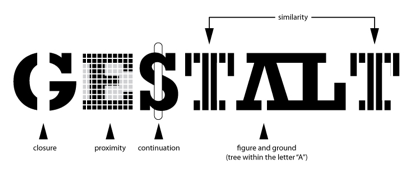
source: http://yusylvia.files.wordpress.com/2010/03/gestalt_illustration-01.jpg
Because of these gestalt principles, we can be tricked into perceiving things are real or possible when they are not. These are called optical illusions. Here are some examples:
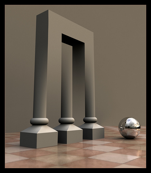
source: http://farm3.static.flickr.com/2179/2240802625_0c0d6b0a9b.jpg
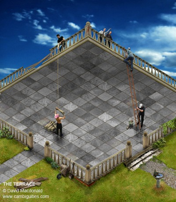
source: http://www.innocentenglish.com/funny-pics/best-pics/terrace-optical-illusion.jpg



